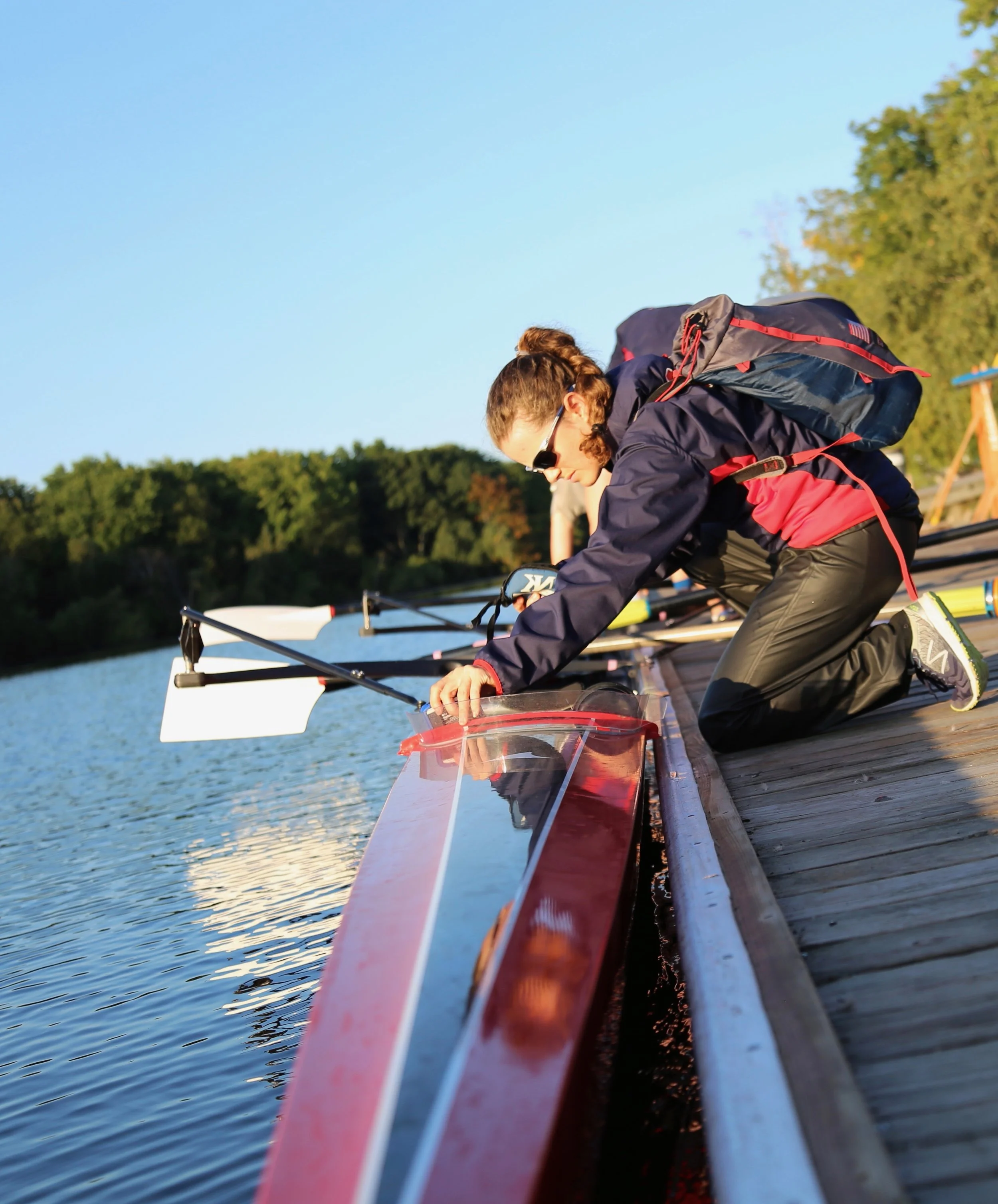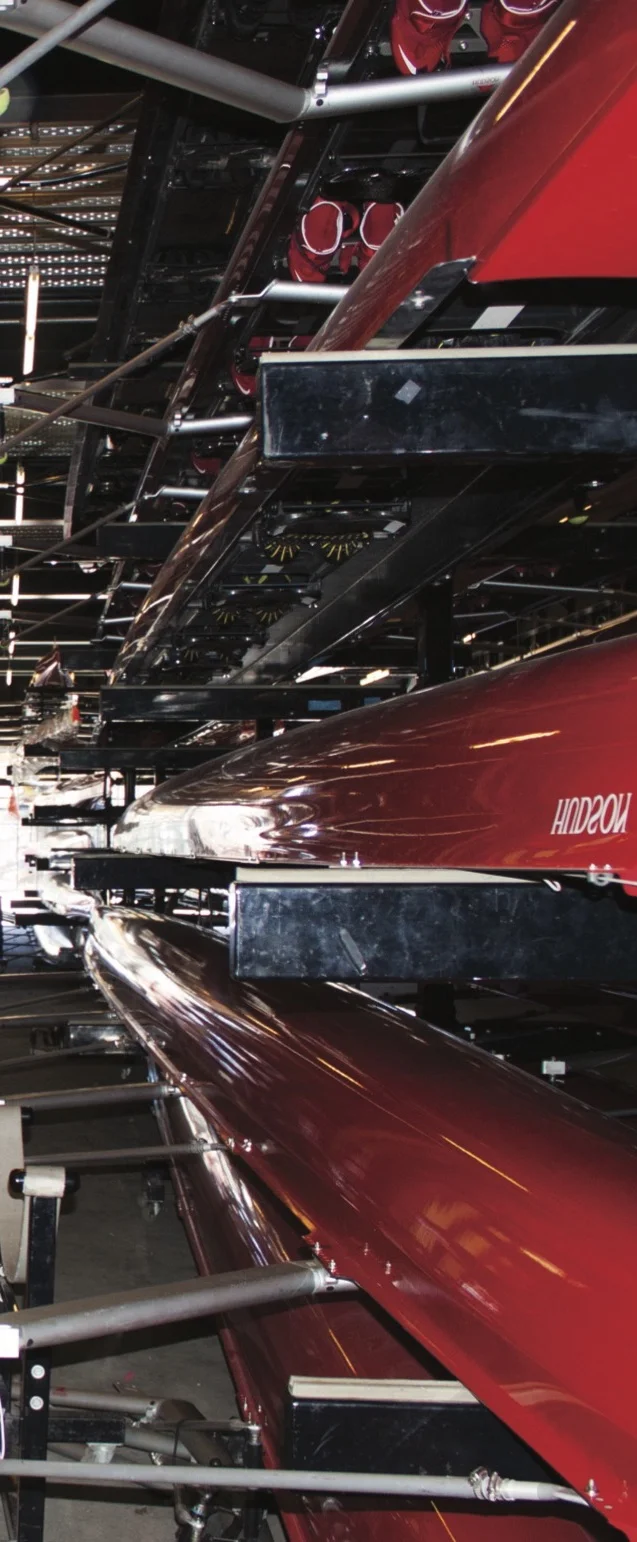The first time I met Jenny Sichel it was hot. Oklahoma hot.
You know this kind of hot. It’s the hot that drips from your elbows. It’s the hot that no amount of water or sunscreen can help. It’s the hot that makes everything crystallize–your mind stripping away everything that isn’t essential–as you strive to keep your body temperature below the red line. Somehow, in this type of heat, you become better, more efficient, more direct. And this is what I noticed most as I watched Jenny Sichel cox that first day on the Oklahoma River, the heat as thick as the wind.
Sichel is a two-time World Championship silver medalist (2014 and ’15) as the coxswain of the Legs, Trunk and Arms Mixed Para Four (LTAMix4+). She’s compact and has curly hair that she keeps back in a ponytail most of the time. But when I first met her, in the summer of 2010, at a training camp for adaptive athletes seeking to make the national team, her hair was bob-short. Sichel had just graduated from Bryn Mawr College with a degree in mathematics and had been involved in rowing for four years.
As the athletes who were with us at the development camp gathered in the cinderblock dorm the first night, Jenny and Chris Livesay, a veteran of the war in Afghanistan who had lost his leg to a roadside bomb, sat in the hallway lounge chairs. Jenny was teaching Chris how to add beads onto the short braids in her hair. “It’s a ritual that I started for my first race in college,” she told me as the heat of the day was finally being displaced by an evening breeze. “It’s definitely a superstition. I cox better with braids.”
Sichel started rowing at Bryn Mawr College, a small women’s college in Philadelphia, Pennsylvania. “I like to say I majored in rowing, not math,” she says with a laugh, “but my parents don’t particularly like to hear that.” Even though she was only five feet, two inches tall, she rowed bow seat in the varsity boat her freshman year. During her sophomore year, she was moved to the stroke seat and spent most of that fall facing her coxswain. She was tiny for a rower, but her teammates didn’t care; she had a long stroke and set the pace for Bryn Mawr at the Head of the Charles Regatta that year. A herniated disk in the spring of 2008, however, moved her from the boat to the shore, and she spent many practices painting oars while her teammates went out on the water.
Sichel was itching to get back on the water after a month on land. “At the time, we didn’t have anyone who coxed full-time at Bryn Mawr,” Sichel says. She had coxed a bit the previous summer at her local rowing club and decided to change seats. Although she was hesitant at first, this decision put her where her size and her personality could shine. “When I rowed, I didn’t want to be known as a coxswain. This was mostly because I was the stereotypical size for one and I wanted to break the mold,” she says, “but after my injury, I yearned to get back on the water. I tried coxing and for me the seat clicked. Yes, I was the right height and weight, but my personality was also able to come through.”
During our interview, I ask Sichel what made her successful as a coxswain at Bryn Mawr. She pauses for a moment. “I was able to walk that fine line between being an athlete and being a leader,” she says. She touches on something every coxswain has felt, that narrow line of duplicity that is required to be successful. “I’ve never looked at myself as an amazing cox, but what I focused on in college was growing my own voice, both on and off the water. During practices, I listened to my coach. Afterward, I would have meetings with her. I had to learn to navigate that line, transferring what the coach said to the athletes, and vice versa. It’s like being the captain of the team–having that same responsibility–without officially being named the captain.”
Sichel coxed the rest of her college career in the Varsity 8+. “I found I was somewhat natural in that seat. I wondered how good I could be.” And so, after meeting the adaptive national team coach in the summer of 2009, Sichel was invited to a development camp in Oklahoma City. It was there, in the heat of the Oklahoma summer, that Sichel began to cox adaptive boats. After the end of her senior year at Bryn Mawr, her coach, Carol Bower, encouraged her to pursue coxing at the next level.
“By that time,” she says, “the sport had gotten me, hook, line and sinker. I loved the dedication it took, the training to race at that next level.” She pauses here, weighing her words, and then begins describing her passion.
“At that time–and even now–para-rowing is at the point where women’s rowing was in the late ‘70s and early ‘80s. It’s making huge strides and becoming more popular worldwide.” First introduced into the international Paralympic program in 2005, para-rowing was originally included at the 2008 Paralympic Games in Beijing. “The sport has so much more room to grow and I want to grow with that movement.”
Jenny Sichel on the CRI dock
The only coxed boat in para-rowing is the LTAMix4+, with two women and two men as rowers, each qualified as an adaptive athlete. Describing her athletes and a different way to look at their disabilities, she says, “There are some people in the boat that have prosthetics or some people may wear black-out goggles for visual impairment. All athletes have some type of challenge. For rowers in my boat these are more physical.”
I ask Sichel if she’s a different coxswain when she’s with adaptive athletes. Her answer surprises me. “In many ways I’m more particular with my commands. You can’t say, ‘One foot in’ to someone with one leg, or ‘Go get that oar’ to blind athletes. I’m a bit more aware of the directions I give to the athletes and how they can be interpreted.
“Coxing the para boat has made me a better cox in a shorter period of time. Not only have I learned to be more specific and more articulate, but I have grown in my skills for solving problems. It puts you in situations you’d never expect to be in. You’re forced to work through them.” I think to myself that she’s talking about on-the-water coxing of athletes who are blind or use a prosthetic device on a limb, but I’m wrong.
“Because it’s such a new sport, there’s still a lot to be learned. Figuring out how to attach a prosthetic device to the foot stretcher, for instance. Or deciding on rigging measurements for someone that may not get full compression. We’re still testing the waters, still finding ways to get better.”
Sichel has competed at four World Championship events (2010, ’13, ’14, ’15) in the LTAMix4+. The team finished in sixth place in 2010, fourth place in 2013, and has won a silver medal each of the past two years. “Sitting on the starting line of my first World Championship was the most exciting, and one of the scariest, things I’ve done in my life,” she says. “One mistake and there’s someone right behind you, on your heels.” She replays it for me. “You sit on that starting line and they say, ‘USA, Great Britain, Poland, Germany, Russia, Canada’ and the beep goes off. I’ve come a long way from my first international race.” A hesitation, then, “As long as you take what you learn and progress from it, that’s the key.”
I ask her to fast forward to her last World Championship race, in the fall of 2015, in Aiguebelette, France, where the United States led for the first 500 meters but the British boat sneaked past for gold, crossing the line 0.26 seconds ahead of the United States.
“You never know what will happen in a race,” she says, with an audible wince that shows me how much that finish has stayed with her. “You have confidence from the times you’ve been pulling in practice. You know–and love–your crew. You trust your crew. As a coxswain, you know you’re going to react to what happens in the race. Did I know we would be that close to Great Britain?” She grows wistful and immediately goes into analysis mode. “It’s really all about reacting during a race. To get that close to a gold medal... I remember sitting on their deck, seeing our split.” Every coxswain who has ever coxed a race to the wire knows what she’s talking about. “You have to react and fight it out straight to the end. If we hadn’t reacted, the final times would have been further apart.”
I ask her about how she coxes when she’s that close to her competition. “It really depends on what you and your boat have talked about prior to the race. As a coxswain, every practice is for the rowers and you. This concept is something I’ve learned from a lot of...” she waits, knowing I’ll know what she means. As a coxswain, I do, and you probably do, too. “You could call them a lot of ‘helpful critiques.’
“You have to take everything the rowers and coaches tell you during practices and create your own thoughts. Those critiques after my calls give me the awareness necessary to produce more speed.” She goes on, talking about how she developed as a coxswain. “There was one piece of advice from a rower that changed the way I coxed. One day, a Masters rower said to me, ‘Jenny, you have to talk 80% less than you do.’ That completely changed my coxing. All of a sudden, it clicked. Overnight, it made me comfortable with quiet in the boat.” She lets that settle over us. “80%?” I ask. She smiles and nods, then goes on about other aspects of coxing she’s learned.
“As a coxswain, when you first start out, some coaches almost put you on a pedestal in relation to your rowers. But as a coxswain what you need is that athlete-to-athlete relationship.” An excitement in her voice begins to show, and it’s infectious. “In 2012, when I went to Selection Camp, I didn’t know the rowers. I knew how to cox, and I was good at it, but I wasn’t working with them. I was working at them.” I ask her to explain.
“Everyone has different majors in college,” she says. “You’re not going to tell a math major that the rowing stroke is like a haiku. By getting to know your rowers, you’ll know how to cox them. That was one thing I wish I’d learned a little bit sooner.”
When she’s not training, Sichel spends her days as the Para Rowing Coordinator at Community Rowing, Inc. (CRI), in Boston. “It’s one of those sports that anyone–with any disability–can get involved in. I oversee the programming and do a little bit of coaching. Mostly small boats,” she says, “Singles and Doubles, some Quads, some Fours. Since the inception of CRI, para-rowing has been a part of their programming.”
I ask her if she’s going to stick with coxing the adaptive team in the future. “I’m training now for 2016 Paralympic Selection Camp,” she says. “I really enjoy the challenge of coxing two genders and four different disabilities, while moving at speeds no one has seen before. I definitely want to continue coxing and striving to become better in the coming years.” Again, that infectious energy.
“Right now, I try to cox twice a day, although you can only cox when there’s a boat available. But every row–good or bad–helps me be more aware of what’s happening in the boat.” She grows contemplative again. “Coxing is such a public thing. When you’re rowing, in order to get faster, you correct your form. When you’re coxing, you have to correct your thinking, and everyone is listening as you correct yourself. The best thing I can do is to get on the same page with the coach and the rowers.
“It’s a tough business. When what you’re thinking or saying in the boat is ‘wrong,’ or the athletes ‘don’t like it,’ your self esteem can plummet and your thoughts can destroy you. But when you realize that if you didn’t have those embarrassing moments–when you’re learning that awareness–you wouldn’t get any better. Your perception changes. I no longer see criticisms or critiques as a detriment. Like positive comments, I now see them as a way to continue improving.”
In high school, Sichel was, as she puts it, “a band geek.” As a drum majorette her senior year, she led a 100-person band. “It’s the same mindset as coxing,” she says, “the same feeling. When you’re standing on the 50-yard line, two steps out from the band, you’re alone in actuality, but you have an entire team behind you to rely on, and to lead. I used to stand there and think, ‘Here I go. Nothing to do but to do it.’ It’s the same thing when you’re sitting at the starting line of a world championship.”
For Sichel, the try-outs for the 2016 Paralympics loom ahead of her, in Boston. “It’s a camp boat, so they invite two or three coxswains. We seat race. We time trial.” Even though she’s an experienced coxswain, she knows there’s nothing to take for granted.
“Zero-point-two-six seconds,” she says, remembering the 2015 silver medal finish. You can tell she knows. In the coxswain’s seat, every stroke–and every call–is the difference between second and first.
Jenny Sichel, the US National Team LTAMix4+/PR3 Coxswain
"Coxing the para boat has made me a better cox in a shorter period of time."
"You’re not going to tell a math major that the rowing stroke is like a haiku."
One of the boat bays at Community Rowing, Inc.






